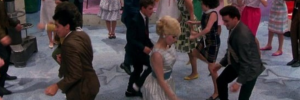Works
Flow 2016: Podcasts and Convergent Digital Media
As part of the tenth anniversary celebration of the landmark open-access media studies publication Flow, I took part in a roundtable discussion titled “Podcasts and Convergent Digital Media” at the Flow Conference in 2016.
“Hairspray and History”: Film 101 Screening Series at the Ambler Theater
As part of the Ambler Theater’s “Film 101” summer screening series, I gave a brief introduction of the cult classic…
“All Culture is Appropriated”: Arcadia University English Language Institute
A lecture about popular culture and “cultural appropriation” for visiting students from DaeJin University in South Korea specializing in American Studies.
SCMS 16: Something On the Air
This presentation, delivered at SCMS ’16, argued for the necessity of film and media scholars to consider the industrial processes of pop music distribution (like radio formats) when considering the ways that music becomes culturally meaningful.
For the Women SPEAK OUT: “On ‘Nice Guy’ Misogyny”
In April 2013, Rose Elyse Coyne of Arcadia University’s student group For the Women invited me to participate in…
Memory, Mourning, and Michael: Jiangsu University, China
This lecture, delivered to the faculty of the School of Foreign Languages at Jiangsu University in China, centered on the use of Fifties style and imagery in the 1980s music videos of Michael Jackson.
IAMHIST 2015
This presentation, delivered to the International Association of Media and History, provided a cultural history of Oldies, as a term, radio format, and genre.
SCMS 15: Soul in the Rear View Mirror
This presentation, which centers on the 1980s film THE BLUES BROTHERS, attempted to place its revival of blues music into the historical and cultural context of the Reagan Era.
Film & History 2014: The ‘New Man’ and Fifties Stardom
This presentation, delivered at the Film and History Conference, was focused on the transformation of James Dean’s star text in popular culture of the 1970s and 1980s.
“That’s Entertainment!” Symposium: “MJ and ‘Real Showmen'”
Michael Jackson experienced resistance from powerful institutions in pop music before his blockbuster 1982 solo album Thriller, and skepticism from some influential Black cultural figures after it. In both cases Jackson partially addressed these challenges through nostalgia-inducing images of the Fifties in his music videos.
SCMS 2013: “The Meaning of the Word Neighbor in Rear Window”
Viewing 1950s records of the New York City Planning Commission and comparing them to the critiques brought forth in Jane Jacobs’ The Death and Life of Great American Cities (1961), this paper will explore the specific historical and spatial representations of urban space in Rear Window, one of film studies’ most important texts.
THATCamp Philly
THATCamp, The Humanities And Technology Camp, is a free, open, interdisciplinary “unconference” where humanists and technologists meet to work together for the common good.
SCMS 2012: “Old Time Rock and Roll”
This presentation examined Reagan Era films that utilized 1950s popular music on their soundtracks to critique or undermine the commodification and depoliticization of Oldies. This, I argued, serves as just one illustration of the complexity and diversity of uses for nostalgia in the 1980s, outside and against the dominant “Reagan Era” narratives that so easily come to mind.
PCMS: “Re-Reading American Graffiti”
In the 1980s, nostalgia for the fifties became an enormously lucrative and politically resonant trope in American popular culture. The text most often identified as the founding document of this “nostalgia wave” in America is American Graffiti (1973).
SCMS 2011: “The Same Old Songs?”
This paper was delivered as part of a panel called “Hollywood on the Air” at the 2011 Society of Cinema…






































